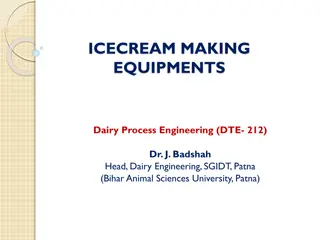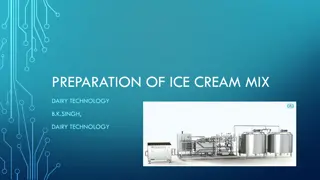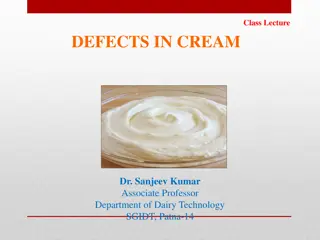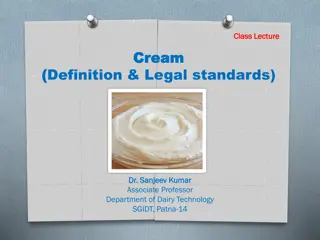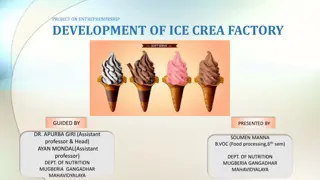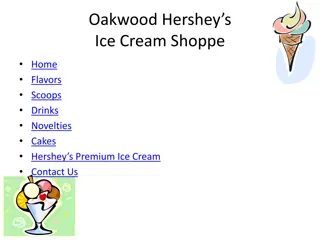Understanding Low-Calorie, Diabetic, and Dietetic Ice Cream
Ice cream is a beloved frozen treat that can be modified to cater to various dietary needs, such as low-calorie, reduced-fat, diabetic-friendly, and dietetic options. From traditional ice cream to probiotic-enhanced variations, this article delves into product standards, fat content guidelines, artificial sweeteners, and innovative approaches to creating healthier frozen desserts.
Download Presentation

Please find below an Image/Link to download the presentation.
The content on the website is provided AS IS for your information and personal use only. It may not be sold, licensed, or shared on other websites without obtaining consent from the author. Download presentation by click this link. If you encounter any issues during the download, it is possible that the publisher has removed the file from their server.
E N D
Presentation Transcript
LOW CALORIE, REDUCED FAT, DIABETIC AND DIETETIC ICE CREAM AND FROZEN DESSERTS Department : Dairy Technology Course Title : Ice Cream & Frozen Desserts Course No. : DTT -222 Course Teacher: Dr. Bipin Kumar Singh
Introduction Ice cream is a sweetened frozen food typically eaten as a snack or dessert. It may be made from dairy milk or cream and is flavoured with a sweetener, either sugar or an alternative, and any spice, such as cocoa or vanilla. Colourings are usually added, in addition to stabilizers. The mixture is stirred to incorporate air spaces and cooled below the freezing point of water to prevent detectable ice crystals from forming. The result is a smooth, semi-solid foam that is solid at very low temperatures. Low-calorie ice creams can be made with low-fat dairy, artificial sweeteners, and/or milk alternatives to cut down on the number of calories. However, that doesn t necessarily make these desserts healthier. Some low-calorie ice creams may be highly processed, while others contain more sugar than regular ice cream.
Low Calorie,Diabetic and Dietetic Ice Cream and Frozen Desserts Low fat ice cream (i.e. ice milk) may be frozen hard, or sold in the form of a soft serve product, as practiced in the US. Two more products with even lower fat contents are also marketed: a) Low fat with not more than 3.0 g of fat per serving and b) Non fat with less than 0.5 g of fat per serving. Low fat ice creams are manufactured with fat substitutes like protein mimetics (e.g. Simplesse) carbohydrates(sucrose polyester) etc.
New standards of identity for ice cream and related products Product fat content Ice cream 10% Reduced fat or light 2-7% Low- fat 0.5-2% Non- fat < 0.05
Probiotic Ice Cream and Frozen Desserts In line with the probiotic yoghurt, probiotic ice cream and frozen desserts have been introduced and well accepted by the health conscious consumers. In such products the basic ice cream mix remains the same, however about 1.5 to 2.0% of an established probiotic microorganism (Bifidobacteriumbifidum, Lactobacillus acidophilus,Lactobacillus rheuteri, etc) with or without a prebiotic (oligofructose, inulin etc) is inoculated in the ice cream mix (preferably without sugar which can be added at a later stage) incubated for few hours, aged and frozen as for regular ice cream. Such product is implicated to improve gut health, retard the level of triglycerides and cholesterol in human subjects. Such product is already launched by AMUL.
Intense Sweetners/Artificial Sweetners/Sugar Substitutes Sugar substitutes may be either caloric or non caloric, depending on their metabolism in the body. High intensity nutritive or calorie sugar substitutes do not contribute significant calories to the products they sweeten because very small quantities of the substance are required to impart sweetener. Mannitol Sorbitol Xylitol Iso-malt Lactitol L-sugar Maltitol Saccharin Aspartame Cyclamate Sucralose
Fat substitutes Fat substitutes or fat replaces can be classified into 3 groups (1) Protein based substitutes eg: Simplesse (2) Oil compounds (3) Carbohydrate based substitutes Some of the fat substitutes that can be used in low calorie foods are a) Sucrose polyesters b) Syntheti coil compounds eg: Trial poxytricaballylate (TATCA) Esterified propoxylated glycerol (EPG) Raffinose polyesters (RPE s) Olestrin and Prolestra
Formulas For Diabetic and Dietetic Frozen Foods The ideal fat level for diabetic frozen dairy foods is 6per cent. The ideal butterfat content for dietetic frozen dairy foods is 3-4per cent and should be made free from substitute sweeteners. Sugar substitutes for diabetic frozen dairy foods include hexahydric alcohols, sucaryl (sodium and calcium), and saccharine. The hexahydric alcohols are classified as sugar alcohols and are made commercially principally from corn sugar and are available as Sorbo (70 per cent of sorbitol and 30% Mannitol). Mannitol has 2 kcal/g and Sorbo has 2.8 kcal/g as compared to 4 kcal/g for sugar. The hexahydric alcohols have about half the sweetening value of sucrose and they affect the freezing point and contribute to the TS as do sugars.
Contd Sucaryl products are non caloric sweetening agents and do not affect the freezing point. Sucaryl sodium is most often used within the rate of 0.8 per cent as it can be added at higher concentration than sucaryl calcium within the rate of 0.5 per cent without affecting the flavor. Sucaryl has a relative sweetness value approximately 30-50 times that of sucrose. Saccharine is a non- caloric sweetening agent. It is excessively sweet and cannot be used in amounts to affect the freezing point or TS. It has a relative sweetness of 300-500 times the sweetness of sucrose. It is used at the approximate rate of 31 g per 100 kg of mix. Diabetic base products are available commercially to build solids when substitute sweeteners are used.
Composition of diabetic and dietetic products Constituents Dibetic medium fat product Dibetic full fat product Dietetic product Low -fat high product fat MSNF sucrose Mannitol(95%t s) 6.0 10.5 - 8.0 10.0 9.0 - 8.0 3.0 12.00 13.00 - 2.00 13.50 13.00 - Sorbo(70%ts) Sucaryl(Na or cl) 0.016-0.021 - - - High protein base or diabetic base 3.0 3.0 3.0 3.0 stabilizer TS 0.3 33.0 0.3 25.5 0.35 31.35 0.35 31.85
Best to read labels when shopping for low-calorie ice cream and review the following Ingredient lists. A longer list generally means the product is highly processed. As ingredients are listed in order of quantity, closely examine those at the beginning. Calories. Though most low-calorie ice creams deliver under 150 calories per serving, the calorie content depends on the brand and ingredients used. Serving size. Serving size can be deceptive, as a small serving will naturally contain fewer calories. There are normally several servings in a single package. Added sugar. Eating too much added sugar is linked to numerous diseases. As such, try to avoid ice creams with more than 16 grams per serving . Saturated fat. Evidence suggests that limiting saturated fat intake especially from sugary, fatty foods like ice cream may reduce your risk of heart disease. Look for alternatives with 3 5 grams per serving.
Healthiest low-calorie ice cream options Some healthier brands of low-calorie ice cream include: Halo Top. This brand offers 25 flavors, only 70 calories per serving, and lower fat and higher protein contents than regular ice cream. You can find Halo Top in both dairy and dairy-free bars and pints. So Delicious Dairy Free. Made from either oat, cashew, coconut, soy, or almond milk, these ice creams contain many organic ingredients. They re also vegan and gluten-free. Yasso. This low-fat alternative is made from Greek yogurt, which increases its protein content. Some flavors are gluten-free. Chilly Cow. This brand uses ultra-filtered milk and offers a whopping 12 grams of protein per serving while remaining low in calories and sugar. However, it s high in carbs.
Contd Arctic Zero. This brand offers nondairy, lactose-free, and light pints with only 40 90 calories per serving. They re also free of sugar alcohols. Cado. This avocado-based ice cream is a dairy-free and paleo-friendly option with several organic ingredients. Enlightened. This high-protein, low-fat brand offers about 80 100 calories per serving. It also produces dairy-free versions. Breyers Delights. This high-protein option is available in multiple flavors. Ben & Jerry s Moo-Phoria Light Ice Cream. This product is low in fat but boasts 140 160 calories per serving, making it higher in calories than many other options on this list.






